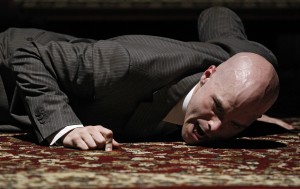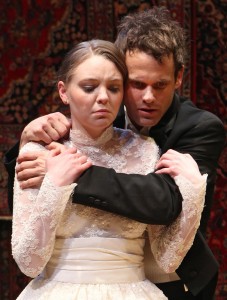Even the most ardent fans of Shakespeare may not have heard of Double Falsehood, which is getting a rare production by Classic Stage Company. It was only last year that the Arden Shakespeare decided to include the play among Shakespeare’s works, with an edition describing its shaky provenance. An 18th-century reworking of a collaboration reputedly by William Shakespeare and John Fletcher, Double Falsehood is presumed by some scholars to be based on Cardenio—the holy grail of lost Shakespeare plays and the first collaboration of the playwrights, whose Henry VIII and Two Noble Kinsmen have survived intact. (Fletcher, no slouch as a playwright, was half of Beaumont and Fletcher, and became the house dramatist for Shakespeare’s company, The King’s Men, after Shakespeare retired.)
Some quick history. Oliver Cromwell and his Puritans closed theaters in 1642, and they weren’t reopened until after the English Civil War, in 1660, with the restoration of the monarchy. Many scripts from earlier in the 17th century ended up in the hands of playhouse owners or producers such as Lewis Theobald (pronounced TIB-alt). In 1727 Theobald’s repurposed version of the drama was staged. Though the play, which was based on an episode from Don Quixote, has been knocking around for more than three centuries, the Arden Shakespeare’s endorsement has given it unexpected attention. A production at the Royal Shakespeare Company in England is planned this year.
Passing through so many hands, the play retains surprising echoes of other Shakespeare works. Two brothers, the decent Roderick and the rakish Henriquez, are sons of a duke (As You Like It), who pretends to have died (Measure for Measure). Henriquez rapes the lovely Violante, then abandons her to pursue Leonora (Hayley Treider), whose father intends her to marry a suitor—Henriquez—against her will (Romeo and Juliet). Leonora’s true love, Clayton Apgar’s dashing Julio, exiles himself to a forest, where, dressed almost naked and smeared with dirt, he goes temporarily mad (King Lear).
The plot elements are common among Shakespeare, Fletcher, and their contemporaries, but the unfamiliarity of this text lends it freshness, and it moves swiftly (a Fletcher strength). The simplicity of Oana Botez-Ban’s design—a series of hanging Oriental rugs, with three on the floor, shifted back and forth—helps focus attention on the story, although in one case the budgeting of actors—Philip Goodwin as the magisterial Duke and distinguished Camillo—may confuse even attentive listeners. Director Brian Kulick has staged the play with a minimum of fuss and even eliminated CSC’s side seating.
The cast clearly relishes the opportunity to create characters from this neglected classical drama. Slate Holmgren as the slimy Henriquez manages to find layers in a stock villain. Even after Henriquez has “reformed,” there’s a lingering suspicion that he’s manipulating people, as he’s forced (the way Lucio is in Measure) to marry the woman he wronged.
Apgar, too, is a fine, heroic Julio. Playing the good guy isn’t usually as interesting as playing the bad one, but Apgar embodies charm and sincerity, strength and honor. And Jon DeVries as Don Bernardo, blessed with a rumbling voice and extraordinary command of verse, makes the most of Leonora’s alternately doting and scheming father, torn between love and greed. He’s a joy to watch whenever he’s on stage.
Only Hayley Treider’s Leonora, and to a lesser extent MacKenzie Meehan’s Violante, occasionally move with more gesturing than women of that period would, and Treider has a habit early on of falling into shrillness. (Botez-Ban has dressed the cast in clothes that mix peasants’ rags with evening dress but reflect no particular era, although they are of more recent vintage.)
Still, even with a Shakespeare name tag, the play never burns brightly. There are no speeches on the order of “To be or not to be” or “Tomorrow and tomorrow and tomorrow” or “The quality of mercy is not strain’d.” Ardent fans who feel they’ll never have another chance to see a production of this historical curiosity are probably right.
Although Double Falsehood is close in temperament to Cymbeline or The Winter’s Tale, two late romances, it can’t touch them. Still, it has charms, good performances, and value beyond scholarship. One hopes that Kulick will start looking at all the playwrights of the period who have been overshadowed by Shakespeare. He’s found a topaz; there are diamonds still out there.








